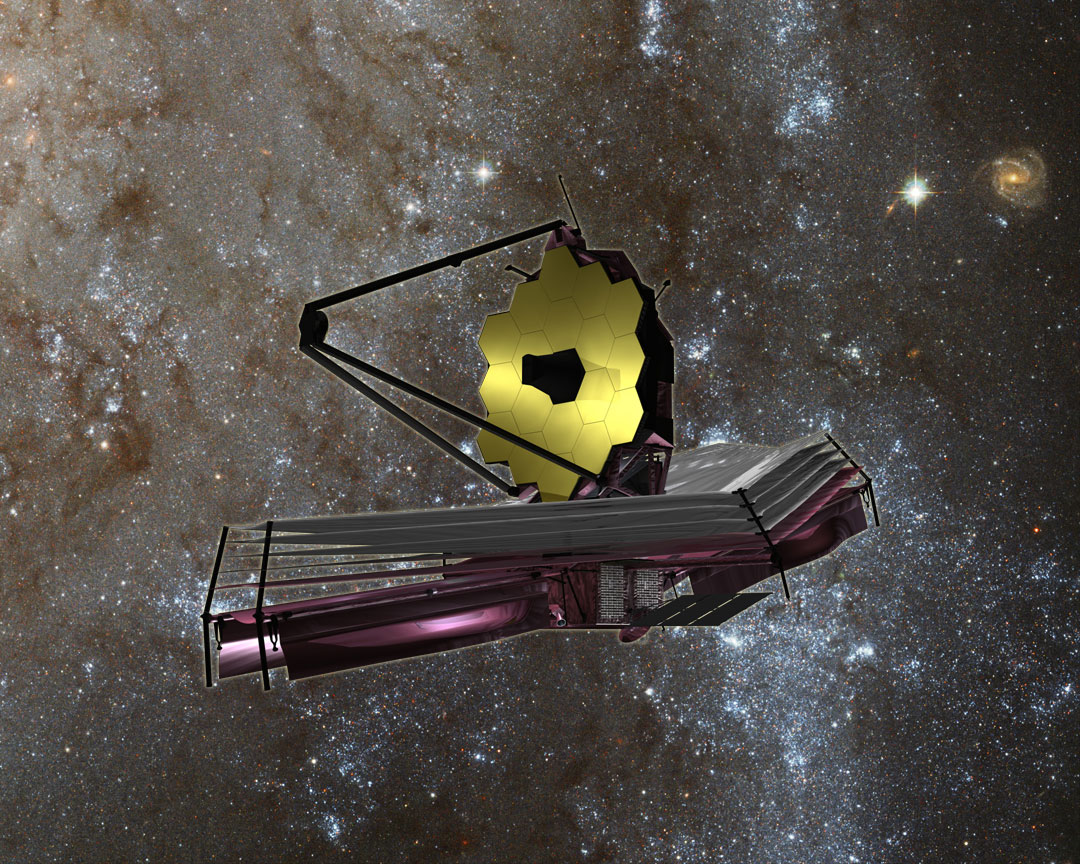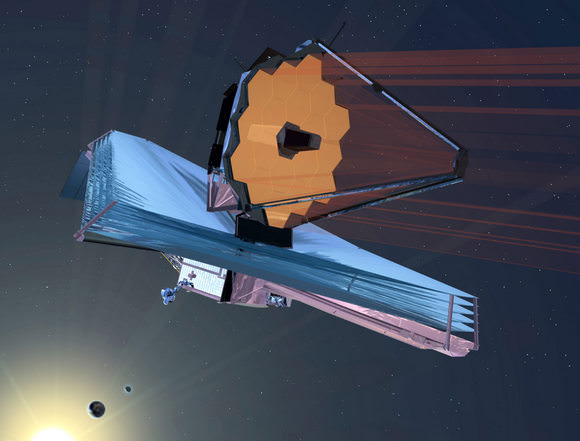The James Webb Space Telescope (JWST) continues to both dazzle and amaze with its latest image, this time of Galaxy IC 5332, also known as PGC 71775, which is an intermediate spiral galaxy located approximately 30 million light years away. This comes after JWST released its first images at its full power, which includes the Carina Nebula, Stephan’s Quintet, Southern Ring Nebula, and SMACS 0723, the last of which was the deepest and sharpest image of the distant universe to date.
Continue reading “Another Amazing Image from Webb, This Time it’s Galaxy IC 5332”James Webb Makes The Journey From Houston To Los Angeles; Last Stop Before It Heads To The Launch Facility In 2019

The two halves of the James Webb Space Telescope are now in the same location and ready to take the next step on JWST’s journey. On February 2nd, Webb’s Optical Telescope and Integrated Science instrument module (OTIS) arrived at Northrop Grumman Aerospace Systems in Redondo Beach, California. The integrated spacecraft, consisting of the spacecraft bus and sunshield, were already there, waiting for OTIS so they could join together and become a complete spacecraft.
“The team will begin the final stages of integration of the world’s largest space telescope.” – Scott Willoughby, Northrop Grumman’s Program Manage for the JWST.
“It’s exciting to have both halves of the Webb observatory – OTIS and the integrated spacecraft element – here at our campus,” said Scott Willoughby, vice president and program manager for Webb at Northrop Grumman. “The team will begin the final stages of integration of the world’s largest space telescope.”

OTIS arrived from the Johnson Space Center in Houston, where it had successfully completed its cryogenic testing. To prepare for that journey, OTIS was placed inside a custom shipping container designed to protect the delicate and expensive Webb Telescope from any damage. That specially designed container is called the Space Telescope Transporter for Air, Road and Sea (STTARS).
STTARS is a massive container, measuring 4.6 meters (15 feet) wide, 5.2 meters (17 feet) tall, and 33.5 meters feet (110) long, and weighing approximately 75,000 kilograms (almost 165,000 pounds). It’s much larger than the James Webb itself, but even then, the primary mirror wings and the secondary mirror tripod must be folded into flight configuration in order to fit.

The next step for the JWST is to join the spacecraft itself with OTIS. Once that happens, JWST will be complete and fully integrated. Then there’ll be more tests called observatory-level testing. After that, another journey inside STTARS to Kouru, French Guiana, where the JWST will be launched in 2019.
“This is a major milestone.” – Eric Smith, director of the James Webb Space Telescope Program at NASA.
“This is a major milestone,” said Eric Smith, director of the James Webb Space Telescope Program at NASA. “The Webb observatory, which is the work of thousands of scientists and engineers across the globe, will be carefully tested to ensure it is ready to launch and enable scientists to seek the first luminous objects in the universe and search for signs of habitable planets.”
You can’t fault people, either NASA personnel or the rest of us, for getting excited about each development in the James Webb Space Telescope story. Every time the thing twitches or moves, our excitement re-spawns. It seems like everything that happens with the JWST is now a milestone in its long, uncertain journey. It’s easy to see why.
The Space Telescope That Almost Wasn’t
The James Webb ran into a lot of problems during its development. As can be expected for a ground-breaking, technology-pushing project like the Webb, it’s expensive. In 2011, when the project was well underway, it was revealed that the Webb would cost $8.8 billion, much more than the initial budget of $1.6 billion. The House of Representatives cancelled the project, then restored it, though funding was capped at $8 billion.
That was the main hurdle facing the development of the JWST, but there were others, including timeline delays. The most recent timeline change moved the launch date from 2017 to Spring 2019. As of now, the James Webb is on schedule, and on target to meet its revised budget.
The First “Super Telescope”
The JWST is the first of the “Super Telescopes” to be in operation. Once it’s in place at LaGrange Point 2 (L2), about 1.5 million km (930,000 miles) from Earth, it will begin observing, primarily in infrared. It will surpass both the Hubble Telescope and the Spitzer Telescope, and will “look back in time” to some of oldest stars and galaxies in the universe. It will also examine exoplanets and contribute to the search for life.
NASA Says James Webb Telescope will Study Solar System’s “Ocean Worlds”
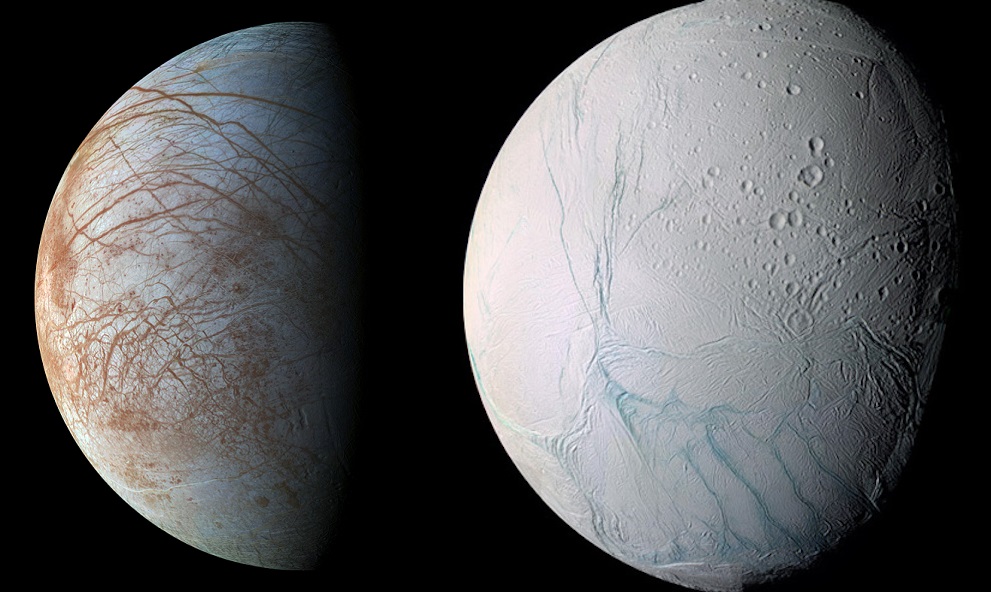
In October of 2018, the James Webb Space Telescope (JWST) will be launched into orbit. As part of NASA’s Next Generation Space Telescope program, the JWST will spend the coming years studying every phase of cosmic history. This will involve probing the first light of the Universe (caused by the Big Bang), the first galaxies to form, and extra-solar planets in nearby star systems.
In addition to all of that, the JWST will also be dedicated to studying our Solar System. As NASA recently announced, the telescope will use its infrared capabilities to study two “Ocean Worlds” in our Solar System – Jupiter’s moon Europa and Saturn’s moon Enceladus. In so doing, it will add to observations previously made by NASA’s Galileo and Cassini orbiters and help guide future missions to these icy moons.
The moons were chosen by scientist who helped to develop the telescope (aka. guaranteed time observers) and are therefore given the privilege of being among the first to use it. Europa and Enceladus were added to the telescope’s list of targets since one of the primary goals of the telescope is to study the origins of life in the Universe. In addition to looking for habitable exoplanets, NASA also wants to study objects within our own Solar System.
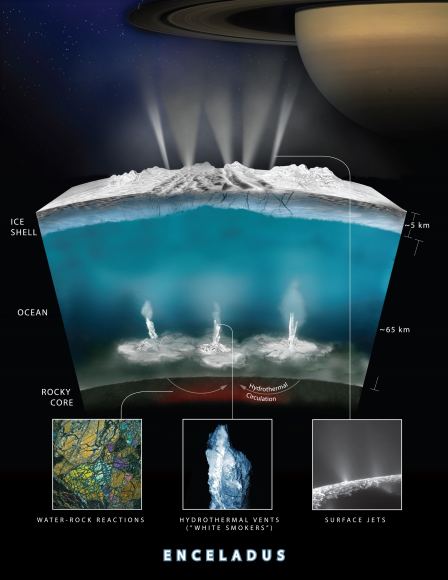
One of the main focuses will be on the plumes of water that have been observed breaking through the icy surfaces of Enceladus and Europa. Since 2005, scientists have known that Enceladus has plumes that periodically erupt from its southern polar region, spewing water and organic chemicals that replenish Saturn’s E-Ring. It has since discovered that these plumes reach all the way into the interior ocean that exists beneath Enceladus’ icy surface.
In 2012, astronomers using the Hubble Space Telescope detected similar plumes coming from Europa. These plumes were spotted coming from the moon’s southern hemisphere, and were estimated to reach up to 200 km (125 miles) into space. Subsequent studies indicated that these plumes were intermittent, and presumably rained water and organic materials from the interior back onto the surface.
These observations were especially intriguing since they bolstered the case for Europa and Enceladus having interior, warm-water oceans that could harbor life. These oceans are believed to be the result of geological activity in the interior that is caused by tidal flexing. Based on the evidence gathered by the Galileo and Cassini orbiters, scientists have theorized that these surface plumes are the result of these same geological processes.
The presence of this activity could also means that these moons have hydrothermal vents located at their core-mantle boundaries. On Earth, hydrothermal vents (located on the ocean floor) are believed to have played a major role in the emergence of life. As such, their existence on other bodies within the Solar System is viewed as a possible indication of extra-terrestrial life.
The effort to study these “Ocean Worlds” will be led by Geronimo Villanueva, a planetary scientist at NASA’s Goddard Space Flight Center. As he explained in a recent NASA press statement, he and his team will be addressing certain fundamental questions:
“Are they made of water ice? Is hot water vapor being released? What is the temperature of the active regions and the emitted water? Webb telescope’s measurements will allow us to address these questions with unprecedented accuracy and precision.”
Villanueva’s team is part of a larger effort to study the Solar System, which is being led by Heidi Hammel – the executive VP of the Association of Universities for Research in Astronomy (AURA). As she described the JWST’s “Ocean World” campaign to Universe Today via email:
“We will be seeking signatures of plume activity on these ocean worlds as well as active spots. With the near-infrared camera of NIRCAM, we will have just enough spatial resolution to distinguish general regions of the moons that could be “active” (creating plumes). We will also use spectroscopy (examining specific colors of light) to sense the presence of water, methane and several other organic species in plume material.”
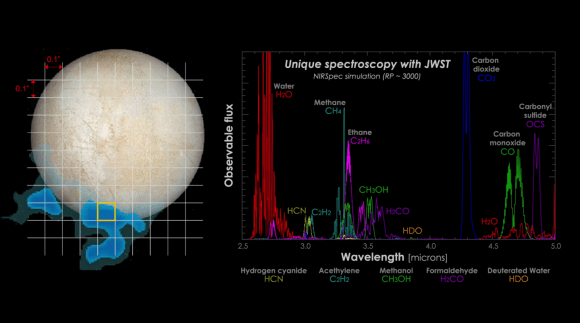
To study Europa, Villanueva and his colleagues will take high-resolution imagery of Europa using the JWST’s near-infrared camera (NIRCam). These will be used to study the moon’s surface and search for hot spots that are indicative of plumes and geological activity. Once a plume is located, the team will determine its composition using Webb’s near-infrared spectrograph (NIRSpec) and mid-infrared instrument (MIRI).
For Enceladus, the team will be analyze the molecular composition of its plumes and perform a broad analysis of its surface features. Due to its small size, high-resolution of the surface will not be possible, but this should not be a problem since the Cassini orbiter already mapped much of its surface terrain. All told, Cassini has spent the past 13 years studying the Saturn system and will conclude the “Grande Finale” phase of its mission this September 15th.
These surveys, it is hoped, will find evidence of organic signatures in the plumes, such as methane, ethanol and ethane. To be fair, there are no guarantees that the JWST’s observations will coincide with plumes coming from these moons, or that the emissions will have enough organic molecules in them to be detectable. Moreover, these indicators could also be caused by geological processes.
Nevertheless, the JWST is sure to provide evidence that will allow scientists to better characterize the active regions of these moons. It is also anticipated that it will be able to pinpoint locations that will be of interest for future missions, such as NASA’s Europa Clipper mission. Consisting of an orbiter and lander, this mission – which is expected to launch sometime in the 2020s – will attempt to determine if Europa is habitable.
As Dr. Hammel explained, the study of these two “Ocean Moons” is also intended to advance our understanding about the origins of life in the Universe:
“These two ocean moons are thought to provide environments that may harbor water-based life as we know it. At this point, the issue of life elsewhere is completely unknown, though there is much speculation. JWST can move us closer to understanding these potentially habitable environments, complementing robotic spacecraft missions that are currently in development (Europa Clipper) and may be planned for the future. At the same time, JWST will be examining the far more distant potentially habitable environments of planets around other stars. These two lines of exploration – local and distant – allow us to make significant advances in the search for life elsewhere.”
Once deployed, the JWST will be the most powerful space telescope ever built, relying on eighteen segmented mirrors and a suite of instruments to study the infrared Universe. While it is not meant to replace the Hubble Space Telescope, it is in many ways the natural heir to this historic mission. And it is certainly expected to expand on many of Hubble’s greatest discoveries, not the least of which are here in the Solar System.
Be sure to check out this video on the kinds of spectrographic data the JWST will provide in the coming years, courtesy of NASA:
Further Reading: NASA
NASA Webb Telescope Resumes Rigorous Vibration Qualification Tests


Engineers have resumed a series of critical and rigorous vibration qualification tests on NASA’s mammoth James Webb Space Telescope (JWST) at NASA’s Goddard Space Flight Center, in Greenbelt, Maryland to confirm its safety, integrity and readiness for the unforgiving environment of space flight, after pausing due to a testing ‘anomaly’ detected in early December 2016.
The vibration tests are conducted by the team on a shaker table at Goddard to ensure Webb’s worthiness and that it will survive the rough and rumbling ride experienced during the thunderous rocket launch to the heavens slated for late 2018.
“Testing on the ground is critical to proving a spacecraft is safe to launch,” said Lee Feinberg, an engineer and James Webb Space Telescope Optical Telescope Element Manager at Goddard, in a statement.
“The Webb telescope is the most dynamically complicated article of space hardware that we’ve ever tested.”

Testing of the gargantuan Webb Telescope had ground to a halt after a brief scare in early December when technicians initially detected “anomalous readings” that raised potential concerns about the observatories structural integrity partway through a preplanned series of vibration tests.
“On December 3, 2016, vibration testing automatically shut down early due to some sensor readings that exceeded predicted levels,” officials said.
Thereafter, engineers and technicians carried out a new batch of intensive inspections of the observatory’s structure during December.
Shortly before Christmas, NASA announced on Dec. 23 that JWST was deemed “sound” and apparently unscathed after engineers conducted both “visual and ultrasonic examinations” at NASA’s Goddard Space Flight Center in Maryland. Officials said the telescope was found to be safe at this point with “no visible signs of damage.”
As it turned out the culprit of the sensor anomaly was the many “tie-down … restraint mechanisms ” that hold the telescope in place.
“After a thorough investigation, the James Webb Space Telescope team at NASA Goddard determined that the cause was extremely small motions of the numerous tie-downs or “launch restraint mechanisms” that keep one of the telescope’s mirror wings folded-up for launch,” NASA officials explained in a statement.
Furthermore engineers revealingly discovered that “the ground vibration test itself is more severe than the launch vibration environment.”

NASA reported today (Jan. 25) that the testing resumed last week at the point where it had been paused. Furthermore the testing was completed along the first of three axis.
“In-depth analysis of the test sensor data and detailed computer simulations confirmed that the input vibration was strong enough and the resonance of the telescope high enough at specific vibration frequencies to generate these tiny motions. Now that we understand how it happened, we have implemented changes to the test profile to prevent it from happening again,” explained Feinberg.
“We have learned valuable lessons that will be applied to the final pre-launch tests of Webb at the observatory level once it is fully assembled in 2018. Fortunately, by learning these lessons early, we’ve been able to add diagnostic tests that let us show how the ground vibration test itself is more severe than the launch vibration environment in a way that can give us confidence that the launch itself will be fully successful.”
The next step is to resume and complete shaking the telescope in the other two axis, or “two directions to show that it can withstand vibrations in all three dimensions.”
“This was a great team effort between the NASA Goddard team, Northrop Grumman, Orbital ATK, Ball Aerospace, the European Space Agency, and Arianespace,” Feinberg said. “We can now proceed with the rest of the planned tests of the telescope and instruments.”
NASA’s James Webb Space Telescope is the most powerful space telescope ever built and is the scientific successor to the phenomenally successful Hubble Space Telescope (HST). The mammoth 6.5 meter diameter primary mirror has enough light gathering capability to scan back over 13.5 billion years and see the formation of the first stars and galaxies in the early universe.
The Webb telescope will launch on an ESA Ariane V booster from the Guiana Space Center in Kourou, French Guiana in 2018.
But Webb and its 18 segment “golden” primary mirror have to be carefully folded up to fit inside the nosecone of the Ariane V booster.
“Due to its immense size, Webb has to be folded-up for launch and then unfolded in space. Prior generations of telescopes relied on rigid, non-moving structures for their stability. Because our mirror is larger than the rocket fairing we needed structures folded for launch and moved once we’re out of Earth’s atmosphere. Webb is the first time we’re building for both stability and mobility.” Feinberg said.
“This means that JWST testing is very unique, complex, and challenging.”
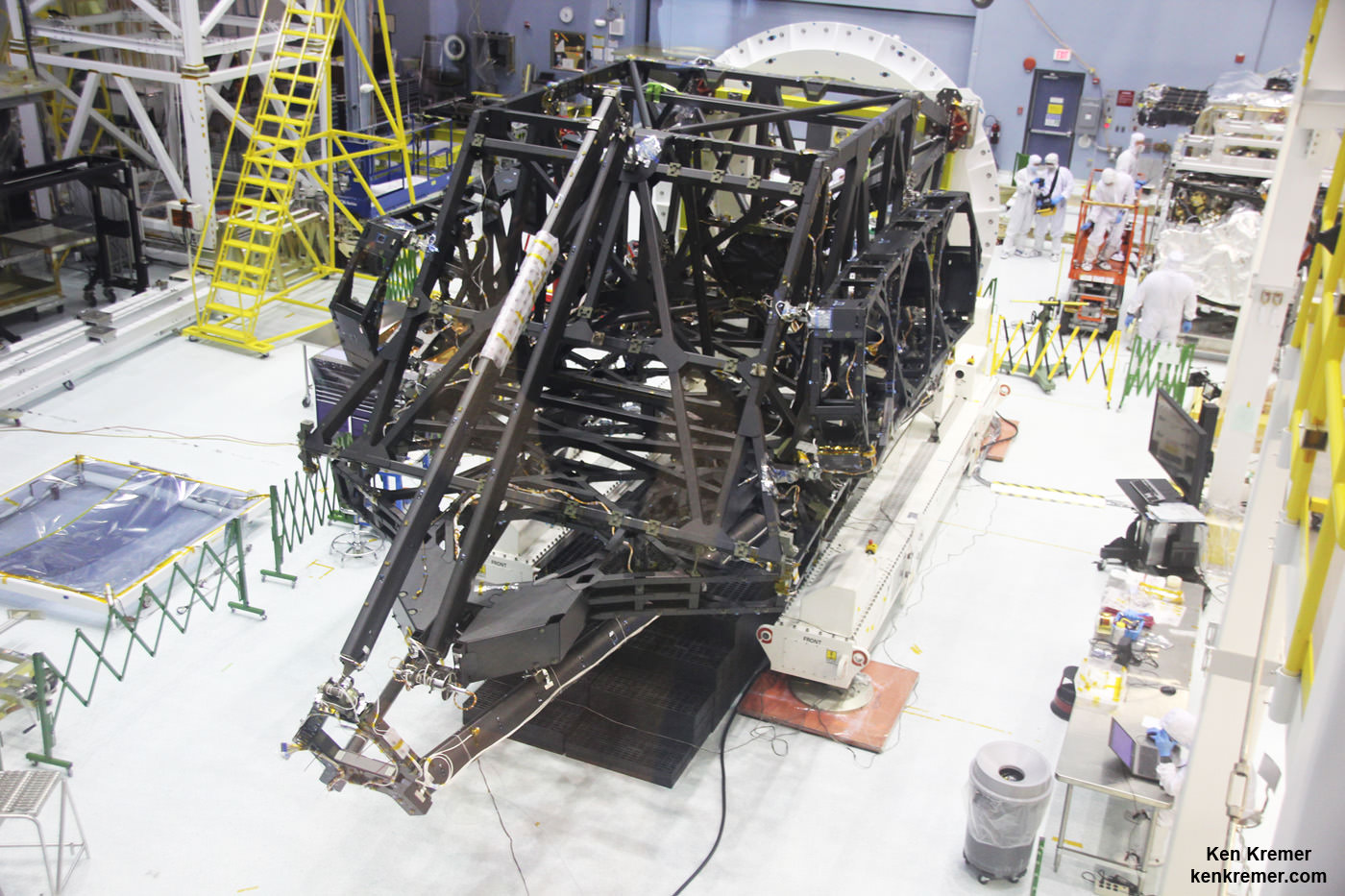
The environmental testing is being done at Goddard before shipping the huge structure to NASA’s Johnson Space Center in February 2017 for further ultra low temperature testing in the cryovac thermal vacuum chamber.
The 6.5 meter diameter ‘golden’ primary mirror is comprised of 18 hexagonal segments – looking honeycomb-like in appearance.
And it’s just mesmerizing to gaze at – as I had the opportunity to do on a few occasions at Goddard this past year – standing vertically in November and seated horizontally in May.
Each of the 18 hexagonal-shaped primary mirror segments measures just over 4.2 feet (1.3 meters) across and weighs approximately 88 pounds (40 kilograms). They are made of beryllium, gold coated and about the size of a coffee table.
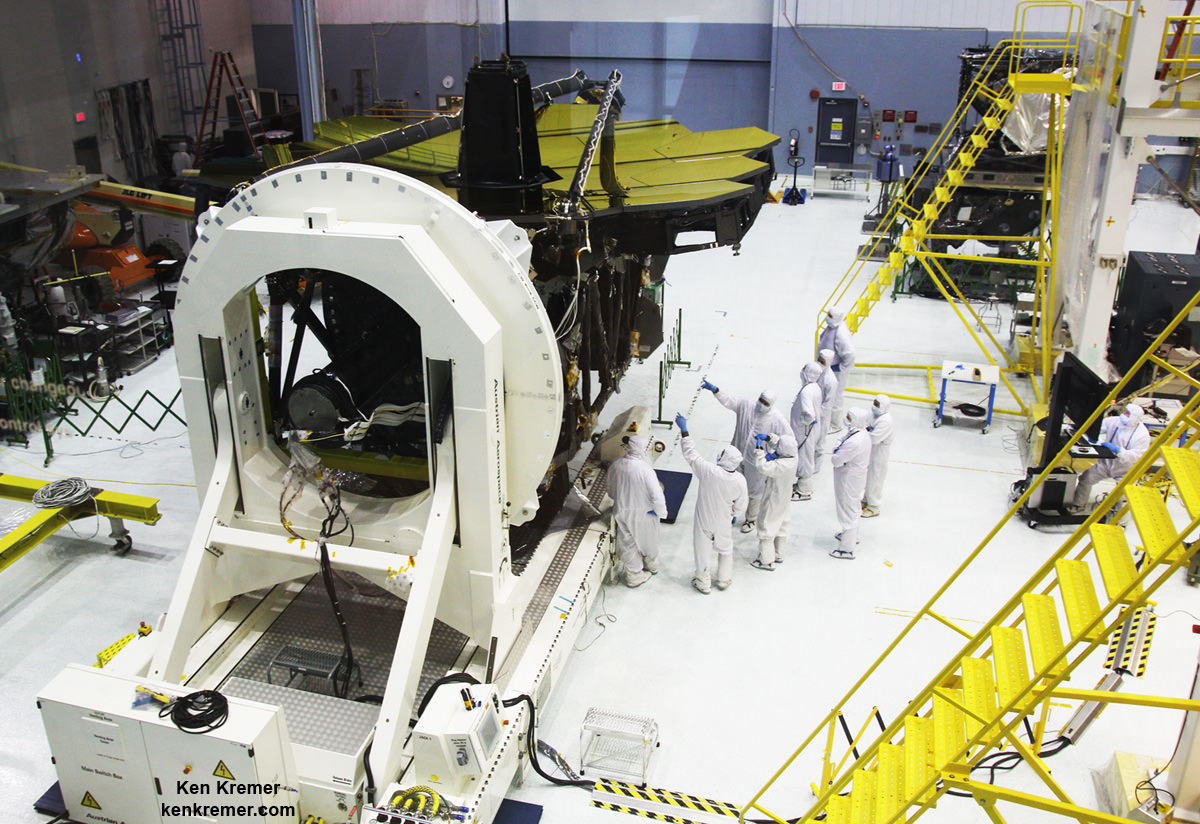
The Webb Telescope is a joint international collaborative project between NASA, the European Space Agency (ESA) and the Canadian Space Agency (CSA).
Webb is designed to look at the first light of the Universe and will be able to peer back in time to when the first stars and first galaxies were forming. It will also study the history of our universe and the formation of our solar system as well as other solar systems and exoplanets, some of which may be capable of supporting life on planets similar to Earth.
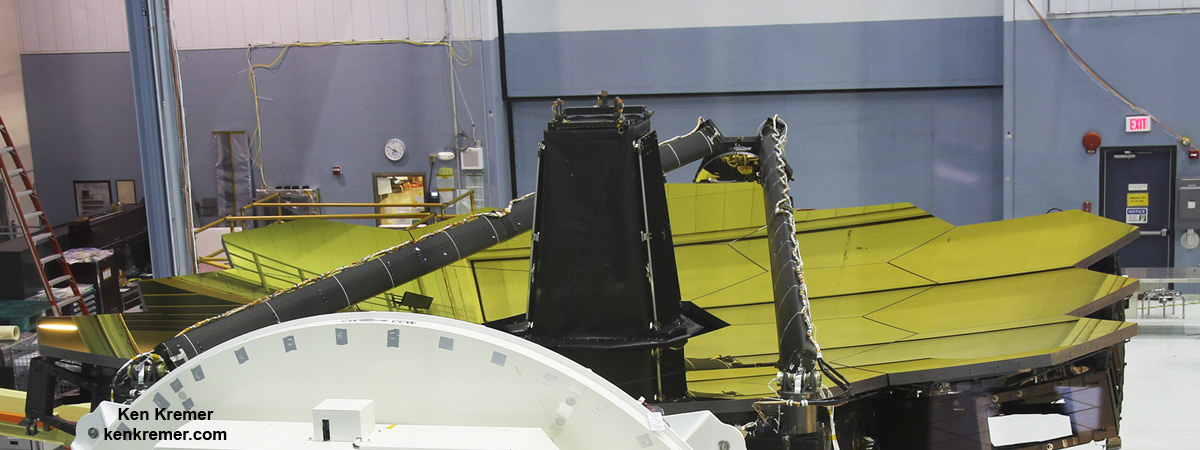
Watch this space for my ongoing reports on JWST mirrors, science, construction and testing.
Stay tuned here for Ken’s continuing Earth and Planetary science and human spaceflight news.
Costs for James Webb Telescope Soar — Again
[/caption]
The price tag for NASA’s next big space telescope keeps rising and the launch date will likely be delayed as well. A new report from an independent panel on the James Webb Space Telescope reveals it will take about $6.5 billion to launch and run the telescope for its projected 10-year mission. The price had previously ballooned from $3.5 billion to $5 billion. Originally the telescope was slated to launch in 2007, but was pushed back to 2014. Now, the panel says, the earliest launch date would be in September 2015.
The panel, requested by Congress, said there appears to be no technical issues with the telescope, but budget and management problems are the reasons for the cost overruns and delays.
“There is no reason to question the technical integrity of the design or of the team’s ability to deliver a quality product to orbit,” said John Casani from the Jet Propulsion Lab, who chaired the panel. “The problems causing cost growth and schedule delays have been associated with budgeting and program management, not technical performance.”
The money to cover the overruns will require $250 million more in NASA’s FY 2011 and 2012 budget. But with the current state of affairs in the country and Congress, it is likely other programs will suffer or be cut in order to pay for JWST.
In a teleconference with reporters, NASA associate administrator Chris Scolese admitted that NASA officials did not do a very good job of keeping track of what was going on with the massive telescope project.
“We were missing a certain fraction of what was going on,” Scolese. “The fault lies with us.”
The panel concluded that the budget was not sufficient in the early days of the telescope’s development for everything to go as hoped.
“The budget was flawed, from a money standpoint it was just insufficient to carry out the work,” said John Klineberg, a member of the panel and a retired engineer. “The budget was skewed, and the reserves to complete the work were also wrong because they were predicated on a budget that was too low. Headquarters did not spot the errors, and they didn’t fully recognize the extent to which the budget was understating the needs of the project.”
“This is a large, complex project and to estimate something to a real degree of precision is hard,” Klineberg added.
The panel found no way for current costs to be reduced, but found ways to reduce the likelihood of cost-growth in the future.
In order for JWST to be built and launched, the panel said NASA should restructure the project organization at Goddard Spaceflight Center to improve the accounting of costs and reserves. The program will now report directly to the Administrator’s office. Richard Howard will be the new JWST program director, replacing Phil Sabelhaus.
“We have to focus on doing what is right to get the project back on track,” said Scolese, “but I want to emphasize that there are no technical problems with the telescope and we have to thank the team for doing a great technical job. The important thing we have to fix is the cost management at the project level and at the management level.”
In a statement, NASA Administrator Charlie Bolden said, “I am disappointed we have not maintained the level of cost control we strive to achieve, something the American taxpayer deserves in all of our projects….NASA is committed to finding a sustainable path forward for the program based on realistic cost and schedule assessments.”
The teleconference with journalists included a first – at least for this reporter: one caller berated NASA management and swore at Scolese, obviously frustrated by the lack of oversight by NASA on what is supposed to be a flagship mission for the space agency’s astronomy division.
The infrared telescope will have a 6.5 meter (22 ft.) mirror and a sunshade the size of a tennis court. JWST should be able to look back in time to find the first galaxies that formed in the early Universe, and to peer inside dust clouds where stars and planetary systems are forming.
Read the report (pdf): James Webb Space Telescope Independent Comprehensive Review Panel — Nov. 10, 2010


